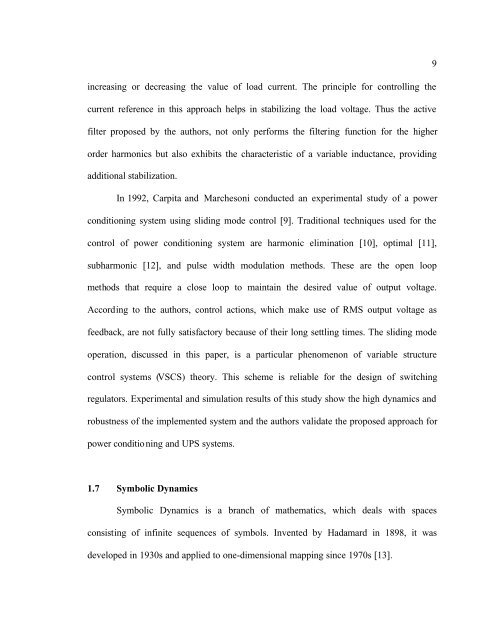symbolic dynamic models for highly varying power system loads
symbolic dynamic models for highly varying power system loads
symbolic dynamic models for highly varying power system loads
You also want an ePaper? Increase the reach of your titles
YUMPU automatically turns print PDFs into web optimized ePapers that Google loves.
9<br />
increasing or decreasing the value of load current. The principle <strong>for</strong> controlling the<br />
current reference in this approach helps in stabilizing the load voltage. Thus the active<br />
filter proposed by the authors, not only per<strong>for</strong>ms the filtering function <strong>for</strong> the higher<br />
order harmonics but also exhibits the characteristic of a variable inductance, providing<br />
additional stabilization.<br />
In 1992, Carpita and Marchesoni conducted an experimental study of a <strong>power</strong><br />
conditioning <strong>system</strong> using sliding mode control [9]. Traditional techniques used <strong>for</strong> the<br />
control of <strong>power</strong> conditioning <strong>system</strong> are harmonic elimination [10], optimal [11],<br />
subharmonic [12], and pulse width modulation methods. These are the open loop<br />
methods that require a close loop to maintain the desired value of output voltage.<br />
According to the authors, control actions, which make use of RMS output voltage as<br />
feedback, are not fully satisfactory because of their long settling times. The sliding mode<br />
operation, discussed in this paper, is a particular phenomenon of variable structure<br />
control <strong>system</strong>s (VSCS) theory. This scheme is reliable <strong>for</strong> the design of switching<br />
regulators. Experimental and simulation results of this study show the high <strong>dynamic</strong>s and<br />
robustness of the implemented <strong>system</strong> and the authors validate the proposed approach <strong>for</strong><br />
<strong>power</strong> conditioning and UPS <strong>system</strong>s.<br />
1.7 Symbolic Dynamics<br />
Symbolic Dynamics is a branch of mathematics, which deals with spaces<br />
consisting of infinite sequences of symbols. Invented by Hadamard in 1898, it was<br />
developed in 1930s and applied to one-dimensional mapping since 1970s [13].
















